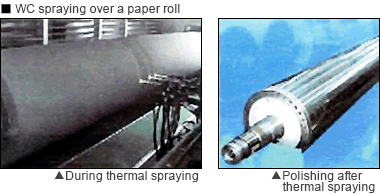(3) Pores on the films
During thermal spraying in the air, flying particles are exposed to the air. As a result, the surfaces of flying particles will be covered with oxide films, or particles in the semi-solid or melted state will collide with the substrate because they are cooled too fast.Since the thermal spraying films are the layers of these particles deposited, they contain tiny pores.
The porosity changes by the spraying methods, materials, and conditions, but it is usually somewhere between 1% and 8%. The porous films containing these pores have oil-bearing properties, meaning that they retain lubricant and are abrasion resistant. These pores are also known to have adiabatic and soundproof effects.
On the other hand, when porous films are placed in the corrosive environment containing corrosive liquid or gas, the substrate is prone to corrosion, and the coatings may peel off or they are likely to develop swelling when corrosive products enter into these holes.
To prevent such problems, sealing treatment is applied.The sealing treatment includes application of sealer made of silicic acid-based resin, phenol resin, or fluorine-based resin, baking, plating, and other methods.
Another common method adopted for ceramic thermal spraying films is to spray metal on top of them and melt it with heat.
(4) Roughness of the film surface
Right after the thermal spraying application, the surfaces are rough.The degree of roughness will vary based on spraying method, spraying materials, granularity, spraying conditions, and sandblasting particle sizes. For example, using #325 carbide sprayed by the high velocity flame method, the surface roughness will turn out to be around 1 to 3 Ra.
Depending on the intended use, this type of roughness can be reduced by post-processing, such as polishing. To take advantage of the larger friction coefficient resulting from the rough surface, it is used as-is for paper-feeding rolls, or to improve the heat efficiency by the increased surface area, it is used as-is.
(5) Hardness of the films
To measure the hardness of thermal spraying films, the micro Vickers hardness is commonly used for the load 0.1 to 0.3 N. Since the films contain pores, notice that the measured values may be inconsistent.
[Table 1] shows an example of physical properties that the films will have. The films are not only used for improving abrasion resistance but also adopted for the fittings of aircraft parts, because the layers of deposited spray particles are capable of dispersing stress.
[Table 1] Example of thermal spraying films physical properties
| Spraying materials | Coating hardness Hv (0.2) | Surface roughness (RZ) |
| Ni-Cr-Mo | 250 - 350 | 110 |
| Ni-Cr-Mn | 350 - 480 | 150 |
| Co-Mo-Cr | 450 - 560 | 30 |
| AL2O3-2.5TiO2 | 700 - 850 | 80 |
| AL2O3-13TiO2 | 650 - 850 | 80 |
| Cr2O3-SiO2-TiO2 | 850 - 1100 | 80 |
|
![[Fig.1] Schematic diagram of a thermal spraying film section [Fig.1] Schematic diagram of a thermal spraying film section](/tt/en/surface/138_1.gif)

